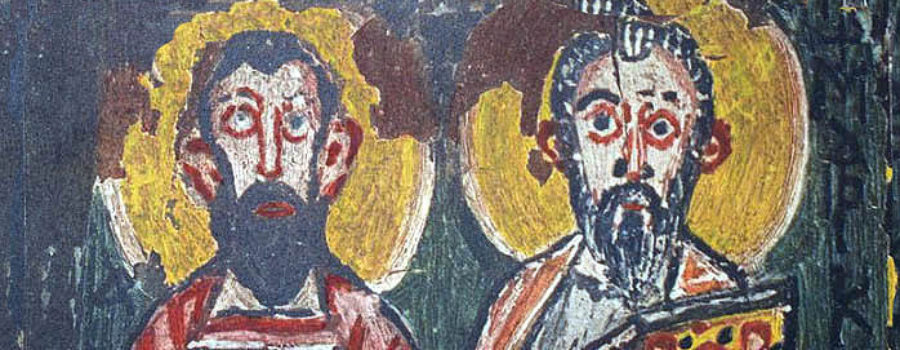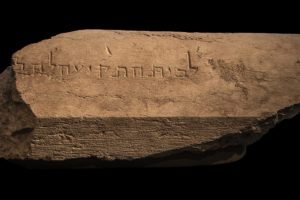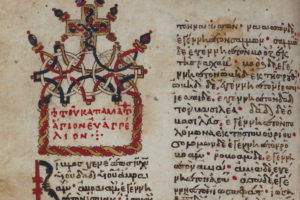When the Apostle Peter completed his portion of the New Testament, and arranged the Scriptures, the Evangelist John Mark was with him. John Mark likely completed his gospel ca. 69 CE at Babylon in Mesopotamia while in the company of Peter. His gospel is essentially a log, expanded notes, of the accounts of Christ’s ministry as preached by Peter over several years.
Its purpose was:
- To preserve and expound the preaching of Peter.
- To provide an account of the life and teachings of Jesus of Nazareth based on the Apostle Peter’s recollections.
- To stress the ministry of Jesus’ and his life and example as a perfect servant of God.
- To emphasize Jesus’ divinity by focusing on his miracles and deeds.
Eusebius records an account by Papias respecting Mark’s gospel as follows:
And John the Presbyter also said this, Mark being the interpreter of Peter, whatsoever he recorded he wrote with great accuracy, but not however, in the order in which it was spoken or done by our Lord, for he neither heard nor followed our Lord, but as before said, he was in company with Peter, who gave him such instruction as was necessary, but not to give a history of our Lord’s discourses: wherefore Mark has not erred in anything, by writing some things as he has recorded them; for he was carefully attentive to one thing, not to pass by anything that he heard, or to state anything falsely in these accounts.
Eusebius, Ecclesiastical History 3.39; Boyle 1955:125.
By “interpreter of Peter” he means that Mark reproduced Peter’s preaching in his gospel (Thiessen 1943:140). According to Eusebius, Irenaeus maintained that Papias “was John’s hearer and the associate of Polycarp” (Eusebius, Ecclesiastical History 3.39; Boyle 1955:125). “But Papias himself,” protests Eusebius, “in the preface to his discourses, by no means asserts that he was a hearer and an eye-witness of the holy apostles, but informs us that he received the doctrines of faith from their intimate friends,…” (Eusebius, Ecclesiastical History 3.39; Boyle 1955:125).
Papias may have been somewhat sensitive when he wrote about Mark’s gospel. Gamble infers that:
…the defensive tenor of his remarks implies that Mark was the object of some criticism, perhaps to the effect that it was incomplete or lacking appropriate arrangement.
Gamble 1985:26. See Eusebius, Ecclesiastical History 3.39; Boyle 1955:125.
The gospel of Mark is brief and reads more as a collection of short accounts loosely tracing the order of events in Jesus’ ministry. Tradition, that is, early oral tradition, suggests that John Mark kept a log of the stories that Peter told concerning Jesus and used these narratives as the basis for forming his gospel account.
Reliance on oral tradition brings with it problems of validity and reliability. Storytelling over many decades increases the likelihood of embellishment. Using Eusebius’ Ecclesiastical History compare the changing nature of an oral tradition reported first by Papias [ca. 80-155] where at 3.39 (Boyle 1955:127) there is no hint or claim of Peter ever having been in Rome nor of Mark writing his gospel in connection with any visit to Rome. Then note how embellished as reported by Irenaeus [ca. 140-ca. 203] at 5.8 (Boyle 1955:187-188) [see also Irenaeus, Against Heresies 3.1.1, Roberts and Donaldson 1987:].
Peter and Paul, so Irenaeus claims, founded the church at Rome and after their departure Mark wrote his gospel based upon Peter’s preaching. Finally notice how the story swelled by the time of Clement of Alexandria [ca. 155-215] where at 6.14 (Boyle 1955:234) he presents Clements’s claim that when Peter preached at Rome the people implored Mark to write his gospel, based upon Peter’s teaching, of which he gave copies away freely. The latter view was also apparently that of Eusebius (Eusebius, Ecclesiastical History 2.14-2.15, Boyle 1955:63-65).
Writing of the Apostle Peter, Justin Martyr refers to Mark’s gospel account as the “memoirs of him” (Justin Martyr, Dialogue with Trypho 106, Roberts and Donaldson 1987:xxx). Origin preserved an early tradition that the writing of Matthew was first, then Mark, then Luke, and finally John (Eusebius 6.25 from his commentary on Matthew). Gamble states that “its author undoubtedly drew on small written sources as well as on the fund of oral traditions” (Gamble 1985:24).
Contemporary scholars regard Mark’s gospel as the earliest of the synoptic gospels with Matthew and Luke dependent upon Mark. The testimony of the ancient church is contra. The traditions known as Q may have been used by Matthew and Luke but Q itself may never have actually existed except as a label for the fund of early oral tradition concerning Jesus. The traditions which occur in Matthew and Luke but not in Mark are known as Q.
Scholars have taken note that the last twelve verses of Mark’s gospel appear to be an addition to the basic text. According to Gamble: “The textual tradition of Mark exhibits a much larger number of scribal corrections than those of other Gospels,…” (Gamble 1985:27). See also Kilpatrick 1957:96. Gamble continues: “For example, Mark originally ended at 16:8 and so lacked any narrative of post-resurrection appearances of Jesus” (Gamble 1985:28). For a scholarly discussion concerning the longer ending of Mark’s gospel see Metzger 1971.
These twelve verses (Mark 16:9-20) are presumably an addition by the Apostle Peter of material he felt needed to be set out in the book. The style of expression in these verses then would be Peter’s and not Mark’s.
Mark’s dependency on Peter’s sermons where Peter gave eyewitness accounts of Jesus’ ministry, words, teachings as well as his own observations as a youth witnessing Jesus’ ministry, and undoubtedly his mother’s stories as well, provides a succinct account of the life and ministry of Jesus. There is no reason to believe that he copied materials from either Matthew or Luke but he appears to simply report the same basic traditions. The work appears to be an independent work from the other gospels. The extant literature of the ancient church uniformly represents Mark as dependent upon the Apostle Peter for his information (Thiessen 1943:143).





Recent Comments